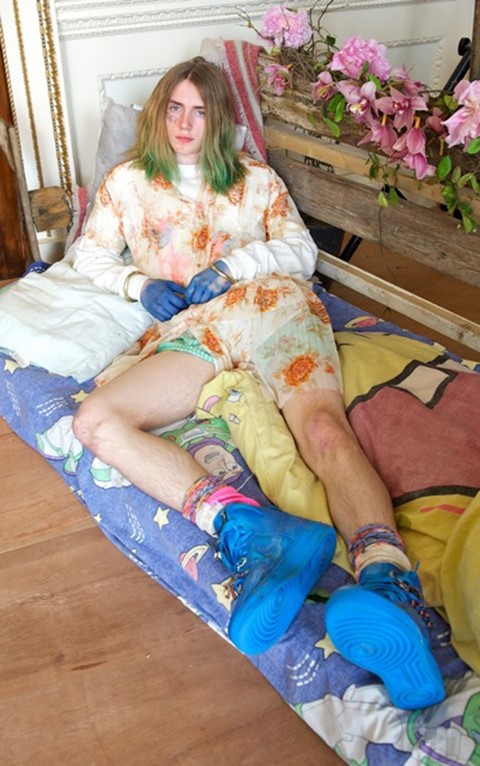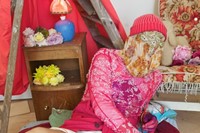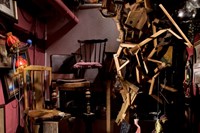Walking on to the set of Meadham Kirchhoff S/S13 men’s presentation was like walking into a particularly psychedelic take on My Own Private Idaho or a hazy daydream come to life...
Walking on to the set of Meadham Kirchhoff S/S13 men’s presentation was like walking into a particularly psychedelic take on My Own Private Idaho or a hazy daydream come to life. The grand sunlit strewn rooms of the Carlton House Terrace were transformed into designer Benjamin Kirchhoff’s idea of “boys living in a squat, there’s a sense of family about it, but it’s also about loneliness.” So models dressed in floral print dresses, hand-dyed tuxedo jackets and paisley skirts mixed in with embroidered balaclavas, lace veils and hi-top trainers sprawled provocatively on dirty mattresses and bathtubs littered with empty pizza boxes, cigarette butts and bottles filled with wilting blooms. The gloriously depraved mise-en-scene suggested equal parts romantic, decadent fantasy and an intensely lived in reality – all trademarks of set designer Tony Hornecker’s aesthetic: “I arrived with two vanloads of rubbish, basically, and put it together on the day. That’s exactly how I like to work – being spontaneous with what I have.”
“I have a real attraction to found materials. I love finding things and recreating them into a new story in a way. For me it’s the most beautiful thing in the world"
For Hornecker, never having a plan is turning out rather well. Having tried out a variety of jobs in his youth, he happened upon set building when he started decorating his home in Dalston and his then-boyfriend, photographer Benjamin Alexander Huseby saw his potential. He shrugs, “Things are a journey I suppose – the next step is taken out of some form of desperation or another.” He has since earned editorial assignments for Dazed & Confused, i-D and Vogue, collaborations with Kylie Minogue, Bat For Lashes and Stella McCartney and, prior to Meadham Kirchhoff, he’s built sets for presentations by Louise Gray, Nasir Mazhar and Richard Nicoll. All the way he’s been refining and evolving his organic, slightly ramshackle and naïve approach. “I have a real attraction to found materials. I love finding things and recreating them into a new story in a way. For me it’s the most beautiful thing in the world.”
Running parallel to all this, his own art is steadily taking centre stage. He started blending his work with his personal life when he started staging acclaimed installations at his home, but it reached an apogee in 2009 at the height of the recession when he turned his home into a temporary restaurant/underground speakeasy: The Pale Blue Door. On any given night, visitors to the restaurant would be treated to a romantic candlelit dinner in a topsy turvy, surreal Wonderland, often serenaded by a crooning drag queen. And while the success of The Pale Blue Door (which he recently resurrected during the Olympics) might have paved the way for the current vogue for pop-up eateries, Hornecker claims not to understand it, “There was something about The Pale Blue Door which you can’t recreate which I’m still proud of and it was amazing for people to experience.”
Never one to stay in one place, Hornecker’s moving on. His restless, peripatetic spirit has seen him create everything from a working bordello for Glastonbury, a shopfront out of a converted garage for the fabulous Jeanette, building tree houses in Kreuzberg to recreating The Pale Blue Door in the exotic climes of Beunos Aires and Chile. A modern day nomad, the romance of the itinerant life is something that appeals to him, saying “It’s about not wanting to settle down I suppose. I love being on the road.” His next project will combine both of his loves: a pop-up space in Soho that will change every three months: “Then I can disappear on my other projects and do a three month stint and come back and make a whole new environment. I’m definitely interested in seeing things grow – an installation that’s constantly getting richer and richer that you can return to and retell the story.”



